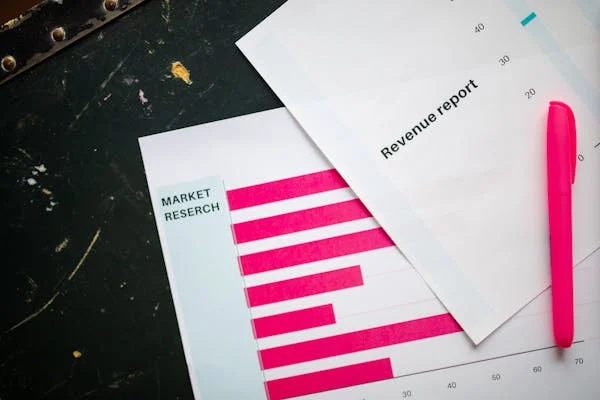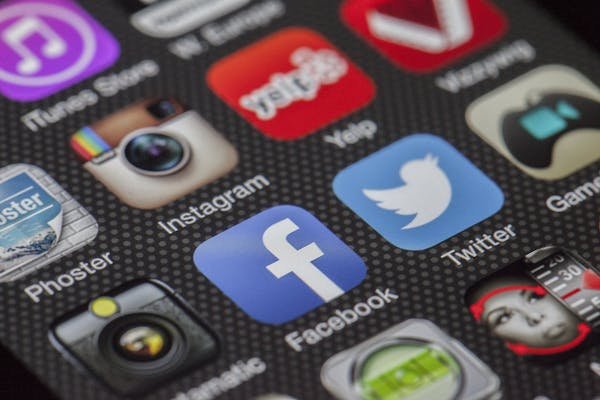Understanding churn is like keeping an eye on your business’s health. Whether you’re running a SaaS company, selling DTC subscriptions, or building a media platform, churn tells you how good you are at keeping your customers. But churn doesn’t look the same everywhere. It depends heavily on your industry, pricing, product type, and audience. This article breaks down 30 real-world stats across SaaS, DTC, and Media — and shows you how to act on each.
1. Average monthly churn rate for SaaS companies is 3–8%
Why this range matters
SaaS companies typically operate on a subscription model where customers pay monthly or yearly for access to software. The 3–8% churn rate tells us how many customers you lose each month. While this range may seem acceptable at first glance, even 5% monthly churn compounds into over 46% annually.
That’s nearly half of your customer base gone if you’re not actively replacing them. Worse, this means that for every 100 customers you gain, you’ll need to acquire another 46 just to stay flat. That puts a lot of pressure on your sales engine.
What influences churn in SaaS
Many factors drive churn in SaaS. Product complexity, lack of onboarding, limited support, unclear value, and high competition all play roles. Poor user experience, bugs, or inconsistent product updates can also push users to look elsewhere. If your tool doesn’t become part of their daily workflow, it’s at risk.
Moreover, the type of SaaS company you are matters. Horizontal tools serving all industries usually face higher churn because they’re easier to replace. Vertical SaaS serving specific industries may enjoy more loyalty, even at a higher price point.
Actionable strategies to bring it down
To reduce churn, focus first on the first 30 days. This is where most drop-off happens. Make onboarding fast, friendly, and frictionless. Use in-app guidance, walkthroughs, and success emails. Teach customers how to use your tool, not just what it does.
Second, monitor usage patterns. Look for signs of disengagement — drop in logins, feature usage, or customer support tickets. Use these signals to trigger reactivation campaigns or customer success outreach.
Finally, build feedback loops. Ask customers why they leave. This helps you fix real issues and gives you a second chance to win them back.
2. Top-performing SaaS companies have churn rates below 1% per month
What makes these companies stand out
The best SaaS companies don’t just attract customers — they keep them. A churn rate below 1% monthly is rare, but it’s a sign of product-market fit, customer satisfaction, and operational excellence. These businesses often have strong customer success teams, predictable outcomes, and products that become essential over time.
These companies don’t rely on tricks or hacks. Instead, they’ve built a tool that is hard to live without. That’s the real goal.
The retention flywheel
These companies usually have a flywheel working in their favor. First, they attract the right customers through targeted messaging and clear onboarding. Then they help those users reach their goals quickly. Once customers get value, they’re more likely to stay, refer others, and expand their usage.
Even better, when customers stick around, lifetime value goes up. This gives companies more breathing room to invest in better support, new features, and deeper education.
How you can get closer to the 1% benchmark
Start by measuring leading indicators — not just churn itself. Look at product adoption, user activation rates, and support satisfaction. Every touchpoint is a chance to either keep a customer or lose one.
Make customer success a core function, not an afterthought. Assign onboarding specialists, hold quarterly check-ins, and set up automated nudges for inactive users.
Also, simplify your pricing and billing. Confusion or surprise charges can kill trust. Transparent communication builds long-term confidence.
Lastly, make it easy for customers to grow with you. If they outgrow your product and you don’t have a plan for that, they’ll leave. Offer flexible plans, add-ons, and scalable solutions.
3. Annual churn in B2B SaaS averages around 10–20%, while B2C SaaS can exceed 40%
The B2B vs B2C churn gap
There’s a big difference between selling software to businesses and selling it to individual consumers. In B2B SaaS, customers tend to stay longer because switching costs are high. The software is usually tied into workflows, teams are trained, and contracts are longer.
But in B2C SaaS, people are more impulsive. They may try a tool, forget about it, or cancel quickly if they don’t get value. That’s why B2C churn often exceeds 40% annually — or even more.
Why B2C SaaS struggles with retention
Consumers today are flooded with options. They’re picky, impatient, and price-sensitive. Many try software out of curiosity or boredom. If they don’t get immediate value or find a cheaper or more fun alternative, they churn fast.
Another challenge? B2C SaaS often relies on freemium or low-cost trials. While this helps with acquisition, it doesn’t always filter for quality leads. As a result, many customers never convert or stick.
How to tailor retention by business type
If you’re in B2B, invest in account management. Even small touches like monthly check-ins or usage reports help reinforce value. Focus on reducing friction across teams. The more teams using your product, the harder it becomes to leave.
In B2C, focus on value delivery from day one. Shorten time-to-value. Automate welcome emails. Build habit-forming loops. Keep pricing simple and highlight the cost of canceling — not in guilt trips, but by showing what they’ll miss.
Gamification can also help. Rewards, points, and streaks encourage repeat use. But don’t overdo it. Value must still lead the way.
4. Freemium SaaS models often experience churn rates above 60% in the first month
The freemium paradox
Freemium models are popular because they make customer acquisition easier. People love free tools, and they’re more likely to sign up without risk. But there’s a hidden cost. When users pay nothing, they often value the product less. This is why churn in freemium SaaS is so high — often over 60% in the first 30 days.
Users explore the product, click around, and if they don’t see instant value, they leave. They may never come back, even if your product is great. This isn’t just lost opportunity — it’s wasted resources.
Why first impressions matter most
In freemium, the product must sell itself. That means your onboarding and initial experience need to be razor sharp. Every user should know exactly what to do, how to get value, and why they should keep coming back — all in the first few minutes.
If users log in once and never return, they likely didn’t find the value fast enough. That’s not their fault — it’s yours.
Practical ways to reduce early churn
Focus on activation, not just signups. What’s the first meaningful action users must take to get real value? Maybe it’s uploading a file, connecting an account, or inviting a team member. Guide them to that step as quickly as possible.
Use in-app cues, friendly emails, and even short videos. Remove obstacles. If possible, ask new users what they want to accomplish, then tailor their experience.
Also, analyze your data. What separates users who stick from those who churn in week one? You’ll often find patterns that you can use to improve flows, feature placement, or even your homepage messaging.
Lastly, don’t be afraid to limit your freemium. If you offer too much for free, users may never upgrade — and still churn. Design your free plan to deliver value, but make the paid version clearly better.
5. Subscription DTC (Direct-to-Consumer) brands have average monthly churn rates between 7–11%
What makes DTC churn different
DTC subscription businesses operate in a totally different world than SaaS. These brands often sell physical products — skincare, snacks, clothes, razors, supplements — on a recurring basis. While churn is still a key metric, the reasons behind it are unique.
In DTC, churn is driven more by consumption habits, lifestyle changes, and product fatigue. Even satisfied customers may cancel simply because they’ve got too much of your product already.
A 7–11% monthly churn rate might sound bad, but it’s actually normal for this space. That said, there are still ways to improve it.
The role of product timing and delivery
One big driver of DTC churn is timing. If customers get products too often, they cancel. If delivery is late or inconsistent, they cancel. If the packaging feels generic or boring, they cancel.
Everything in DTC is about the physical experience. It’s not just what you ship — it’s how it feels when it arrives.
Ways to improve retention in DTC subscriptions
Start by offering flexible frequency. Let customers pause, skip, or reschedule orders. This keeps them in your system without forcing them to cancel.
Then, personalize. Use purchase history, customer feedback, and behavior data to adjust what you send and when. A one-size-fits-all subscription doesn’t work long-term.
Next, improve the unboxing experience. Make it feel premium, even if the product is simple. Great packaging, thank-you notes, and small extras can build emotional loyalty.
Finally, create a relationship. Don’t just send a box — send a story. Email customers regularly with tips, background info, and use cases. Show them how your product fits into their life.
Loyalty programs and exclusive offers also help, but only if the core experience is solid. Fix that first.
6. High-end DTC brands (e.g., fashion or cosmetics) see churn rates closer to 5–6% monthly
The impact of perceived value
In premium DTC categories like fashion and cosmetics, the customer mindset is different. They’re not buying out of necessity. They’re buying because it makes them feel good. Because of that, churn tends to be slightly lower — often around 5–6% monthly.
People who subscribe to luxury skincare or curated fashion boxes usually have higher expectations. But when those expectations are met, they’re also more loyal. The key difference is perceived value. It’s not just about what you ship, but how your product makes them feel.
Why quality and branding are everything
In high-end DTC, your product must deliver on its promise — every single time. If it feels cheap, late, or off-brand, customers will leave. These buyers are picky, and they expect a lot.
Your branding must be sharp, your communication consistent, and your service flawless. A missed delivery or sloppy product can destroy trust quickly.
At the same time, premium buyers want to feel special. If you treat them like everyone else, they’ll churn — even if the product is great.
How to retain premium DTC customers
Start by reinforcing your brand value at every stage. Your website, box, customer service, and even your return policy should all say the same thing: we’re worth it.
Make sure your product quality is exceptional. And don’t just say it — prove it. Share ingredient sourcing, craftsmanship details, and behind-the-scenes looks. Build emotional connection through transparency and storytelling.
Offer personalized options. Let users tweak their subscriptions or choose variations. This sense of control makes the subscription feel more tailored — and harder to cancel.
Also, build a community. Exclusive content, early access, and founder updates make people feel like they’re part of something bigger. And when people feel seen and valued, they stay.
7. Media and streaming services like Netflix report churn between 2–4% monthly in mature markets
Why media churn behaves differently
Media subscriptions are a different game. People subscribe to streaming platforms like Netflix, Disney+, and HBO because they want entertainment. Unlike SaaS or DTC, there’s no learning curve or physical product. You sign up, and within minutes, you’re watching content.
That simplicity lowers barriers to entry — but it also means customers can cancel just as easily. Still, in mature markets, these platforms manage to keep churn between 2–4% monthly. That’s a reflection of both content quality and habit formation.
The role of content velocity and variety
Churn in streaming is heavily tied to content. When a new season of a hit show drops, churn goes down. When there’s a content drought or subscribers feel like they’ve seen everything, churn goes up.
That’s why platforms invest billions in original programming. It’s not just about adding shows — it’s about creating anticipation, conversation, and the fear of missing out.
In mature markets like the US, where these services have been around for years, churn is slightly more stable because users are more embedded. They’ve created profiles, watched series, and built viewing habits. But even then, content gaps or pricing changes can spike cancellations.
What streaming platforms do to keep users
Media platforms fight churn by staying relevant. They build watchlists, recommend new titles, and personalize the homepage. Every scroll, every watch, and every skip tells the algorithm what to show next.
They also use notifications, emails, and trailers to bring people back. Some offer tiered pricing, bundles, or mobile-only plans to capture value-sensitive segments.
For smaller or newer media businesses, the takeaway is this: curate relentlessly. You don’t need 10,000 hours of content, but you do need a reason for users to stay subscribed. That might mean exclusive interviews, behind-the-scenes footage, or themed content drops.
Most importantly, track engagement deeply. If users stop watching, don’t wait until they cancel. Proactively reach out. Suggest content. Re-engage them before they’re gone.
8. News subscription platforms (e.g., digital newspapers) often see churn above 10% monthly
Why news churn is especially tough
Digital news subscriptions are a harder sell than streaming. People value news, but they don’t always want to pay for it — especially when so much is available for free. As a result, news publishers often see monthly churn rates over 10%.
Another challenge is intent. People often subscribe to news during big events — elections, pandemics, or market crashes — and cancel when the news cycle cools. These are short-term, emotion-driven decisions, which makes retention tricky.
Unlike Netflix, there’s no binge-watching here. News is transactional. People read a few articles and move on. So the challenge is to turn that habit into a relationship.
What drives news subscriber churn
First, pricing confusion can be a problem. Many news outlets offer trial deals or limited-time discounts. When the full price kicks in, users cancel unless they see strong ongoing value.
Second, content fatigue is real. If headlines feel repetitive, biased, or too negative, readers disengage. And when content isn’t personalized, it feels irrelevant.
Third, competition is intense. Aggregators like Apple News, Google News, and social media serve up free headlines constantly. Paid outlets must work harder to stand out.
How to build retention in news subscriptions
Focus on engagement, not just access. Give readers tools to personalize their feeds. Let them follow topics, save stories, or create alerts. When content feels tailored, people are more likely to come back.
Build email habits. Daily digests, opinion roundups, and editorial picks can keep users hooked. Push notifications can also work — but only if they’re smart and timely.
Also, reinforce your brand. If people believe in your mission, they’ll stay. Show your editorial process. Highlight your journalists. Give subscribers behind-the-scenes access or early articles. Make them feel like insiders.
And lastly, don’t let price be a surprise. Be transparent from the start. Offer value-based pricing or bundle with other digital products like podcasts, courses, or events. That gives your subscription more weight — and makes it less disposable.
9. Churn rate for mobile app-based SaaS is typically higher, averaging 6–10% monthly
Why mobile SaaS struggles more with churn
Mobile-based SaaS tools — whether for productivity, wellness, fitness, or finance — often face higher churn rates. Why? Because mobile users behave differently. They install apps easily, try them fast, and delete them just as quickly. The average monthly churn for mobile SaaS lands between 6% and 10%.
Mobile users expect immediate value. If they don’t get it in the first session, they rarely return. Push notifications can bring them back, but only if the message is relevant and the experience rewarding.
Another issue: app stores. App store subscriptions are harder to manage, which sounds like a retention win — but it’s a double-edged sword. Confused users may cancel everything instead of figuring out your value.
Factors that increase mobile churn
Most mobile churn comes from low usage. If your app doesn’t become part of a user’s daily or weekly routine, it’s gone. This is especially true for apps that promise long-term outcomes, like meditation or language learning.
UI and UX problems also play a role. Small screens leave no room for confusion. A clunky app loses users instantly. If onboarding isn’t seamless and intuitive, first-day churn spikes.
Pricing confusion hurts too. Many mobile SaaS apps hide pricing behind logins or trials. When users get charged unexpectedly, trust is broken.
How to retain users in mobile-first SaaS
First, simplify your onboarding. Every screen must drive toward activation. Use animations, tooltips, or even onboarding quizzes. Gamify the setup if needed — but only to guide, not to distract.
Next, build habit loops. Daily streaks, usage badges, and reminders can nudge people to return. But again, only if the app delivers value. Don’t rely on tricks — make sure the user sees real progress.
Also, use your data. Track session lengths, tap flows, and drop-off points. When users stop engaging, send targeted reactivation prompts. Offer tips, highlight hidden features, or give content previews.
Finally, test pricing sensitivity. Consider offering weekly or quarterly plans alongside annual ones. Shorter plans may feel safer and reduce sticker shock. Just be careful not to undercut your LTV in the process.
And don’t forget app store reviews. Bad reviews scare away new users and make churn worse. Encourage happy users to leave feedback. Reply publicly to issues and fix bugs fast.
10. SaaS businesses serving SMBs can have churn rates as high as 5–7% monthly
Why SMB churn is naturally higher
Small and medium businesses are volatile by nature. Many are still finding their footing, experimenting with tools, or facing cash flow issues. This makes them more likely to cancel software subscriptions, even if they’re satisfied. For this reason, churn rates in SMB-focused SaaS can hover between 5% and 7% every month.
These customers are also more price-sensitive. If budgets get tight, software often ends up on the chopping block. Worse, if they go out of business — which many do — churn becomes unavoidable.
Another issue? SMBs often lack dedicated users for software tools. The founder or a generalist might be juggling multiple roles, and your product becomes just another thing on their plate.
Common reasons why SMBs churn
Lack of time and poor onboarding are big culprits. Many small business owners don’t have hours to explore your app. If the product isn’t intuitive or the value isn’t immediate, it won’t stick.
Support also plays a huge role. If SMBs can’t get help quickly, they’ll walk away. They don’t have IT departments or onboarding teams to troubleshoot problems.
Finally, change management is harder for small teams. If the person who signed up for your tool leaves, gets overwhelmed, or changes priorities, your product may be dropped without warning.
Strategies to retain SMB customers
Simplicity is everything. Your product must work out of the box, with little explanation. Invest in guided onboarding — short, helpful, and results-driven. A new user should be able to get value within 10 minutes of signing up.
Offer live chat or rapid-response support. Even if your pricing is low, fast help creates loyalty. Make your help content visual, scannable, and mobile-friendly.
Also, tailor communication to their lifecycle. When usage drops, follow up. When customers succeed, celebrate it. Small gestures — like milestone emails or personalized tips — make a difference in this segment.
SMBs are also highly influenced by word-of-mouth. Turn your happiest users into advocates with referral perks or community features. The more embedded your brand becomes, the harder it is to cancel.
11. Enterprise SaaS with annual contracts often reports churn below 1% monthly
Why enterprise churn is so low
Enterprise SaaS plays a different game. These deals are big, long-term, and often structured as annual or multi-year contracts. That alone makes monthly churn almost nonexistent — generally below 1%, sometimes close to zero.
But it’s not just about contract length. Enterprise tools are deeply embedded into operations. They’re used by multiple teams, integrated with other systems, and often backed by training, onboarding, and support from the vendor.
The result? Switching becomes costly and complex. Unless something goes really wrong, most enterprise customers renew — at least for a while.
How enterprise retention is built
Retention at the enterprise level starts long before the customer signs. It’s about expectation-setting during the sales cycle. If you overpromise and underdeliver, churn will hit — just later and harder.
Once the contract is signed, onboarding becomes critical. You need dedicated account managers, onboarding playbooks, and clear success plans. Every stakeholder should know what success looks like — and how you’ll help them get there.
Another reason for low churn is internal ownership. When multiple champions inside a company rely on your software, it creates stickiness. Even if one stakeholder leaves, others remain invested.
How to protect and grow enterprise accounts
Start by mapping your stakeholders. Who uses your product? Who approves renewals? Who influences expansion? Keep them engaged through regular touchpoints — not just during renewal season.
Next, deliver ongoing value. Don’t wait for QBRs to show impact. Send monthly usage summaries, success stories, or performance benchmarks. Show them your product is worth every dollar.
Invest in customer education. Host exclusive webinars, invite users to beta tests, and provide dedicated resources for advanced features. Help them go from basic use to full power.
And always be ready to upsell — not forcefully, but thoughtfully. If a team is growing or taking on new challenges, suggest new modules or services that fit their needs. Expansion revenue is often where the real growth happens in enterprise SaaS.
12. Consumer media platforms with ads (freemium) show churn exceeding 12% per month
The downside of ad-supported models
Freemium media platforms — think ad-supported news apps, streaming radio, or casual video — are easy to try and even easier to abandon. With no upfront cost, users can come and go as they please. This leads to churn rates over 12% monthly, especially when the content feels repetitive or the ads become annoying.
The problem is compounded when competitors offer similar content. If users can get the same value elsewhere — with fewer ads or a better interface — they’ll switch instantly.
Also, users of free products tend to be less invested. They haven’t put money down, so they don’t feel obligated to “get their money’s worth.” That emotional commitment just isn’t there.
What drives high churn in freemium media
Ad fatigue is a major issue. If users are hit with long or irrelevant ads, they bounce. And if your platform doesn’t give them control — like skipping or muting — frustration grows.
Content quality also matters. If users see clickbait, low-quality videos, or outdated news, they won’t stick around. They’ll look for something that feels more curated or professional.
Technical issues like buffering, app crashes, or login problems can also drive users away — especially when they’re not paying to stay.
How to keep users coming back in freemium media
Personalization is your friend. Use browsing behavior to recommend better content. If users find something interesting every time they visit, they’ll come back.
Offer limited customization. Let users choose topics they care about or block certain categories. The more control they have, the more engaged they become.
Make the ad experience better. Shorter ads, relevant targeting, or rewarded ad formats can improve tolerance. If users feel like they’re gaining something (like extra content access), they’re more likely to accept the trade-off.
Also, consider hybrid models. Give free users a taste of premium features — like offline access, exclusive content, or early drops. This not only improves retention, but nudges them toward paid tiers.
And finally, study your data deeply. Which cohorts stick around longest? Which content types reduce churn? Use those insights to double down on what works — and trim what doesn’t.
13. Seasonal DTC subscription boxes (e.g., meal kits, beauty) face churn spikes up to 15% post-holiday
Why seasonality drives churn
Seasonal DTC products like meal kits, skincare boxes, or curated gifts often see a big spike in signups during the holidays. People buy them as gifts, try new products, or simply treat themselves. The challenge? Many of these customers don’t intend to stay.
Once the holidays pass, usage drops off fast. This results in churn rates jumping to 15% or more in January and February. Customers feel the novelty wear off. Gifting season is over, and recurring charges no longer feel justified.
This makes it hard to forecast revenue, plan inventory, and keep growth steady.
What leads to these post-holiday exits
There are two main types of churn here: gift recipients and self-purchasers. Gift recipients never chose the product to begin with. Once the gift cycle ends, they cancel. Self-purchasers often sign up for deals, then churn when the discount ends or normal routines resume.
Add to that New Year budgeting and financial stress, and you’ve got a perfect storm of cancellations.
Also, customers tend to reassess their spending at the start of the year. Anything that doesn’t feel essential is an easy target — especially a subscription box they barely use.
How to reduce churn after seasonal peaks
Start by planning ahead. Before the holiday rush, prepare post-holiday engagement strategies. Think beyond sales — focus on reactivation and relationship-building.
For gift recipients, create onboarding flows that convert them into true fans. Include “thank you” emails, how-to guides, and a follow-up survey to learn their interests. Then offer to personalize the next box.

For self-buyers, remind them of what’s coming next — before they cancel. Tease the next month’s product. Offer flexible plans or loyalty perks for sticking around.
Also, use gifting momentum to your advantage. Give subscribers the option to “gift” their next box to someone else rather than cancel. This turns a cancellation into a new lead.
Finally, track churn triggers. If most cancellations happen after the first billing cycle, test messaging that reassures customers before that point. Re-emphasize value and make it easy to stay — even if they just skip a month.
14. Churn for subscription podcast services can exceed 8% monthly
The challenge with audio-only platforms
Subscription podcast platforms are still relatively new, and they face a tough retention challenge. Unlike video or physical products, audio is often seen as a commodity — especially when so much is free. This leads to churn rates of over 8% monthly, and in some cases, even higher.
The problem is that podcast listeners are spoiled with choices. If your platform doesn’t offer exclusive, must-hear content, users can easily find something similar elsewhere. And when free alternatives exist everywhere, retention becomes an uphill climb.
Why churn is high in podcast subscriptions
First, the content itself can become stale. Many users subscribe for one show or host. When the excitement fades or the release schedule slows down, they cancel.
Second, listeners are passive. They often multitask while consuming content, which makes it harder to build deep loyalty. If your app experience is clunky or not intuitive, they’ll drop off without thinking twice.
Third, podcast subscriptions are usually add-ons. Most people already pay for music, video, or books. Another subscription — especially one that doesn’t feel essential — becomes an easy cut.
Retention strategies that actually work
Your biggest weapon is exclusive content. Not just more content — better content. Behind-the-scenes interviews, early access, or members-only episodes can tip the scale.
Next, bundle value. Offer access to newsletters, downloadable transcripts, or community discussions. If people feel like they’re part of something more than just a stream of audio, they’ll stay.
Push notifications can also help — but don’t overdo it. Use them to promote new drops, bonus content, or personal messages from hosts. Personal connection drives podcast loyalty more than anything else.
Also, make the platform seamless. Integrate bookmarking, offline listening, and playback memory. Small UX wins go a long way.
Finally, give people a reason to upgrade. A free tier should feel good — but the premium tier must feel rewarding. Discounts, guest Q&As, or curated playlists add perceived value that justifies the cost.
15. B2C SaaS trials without a credit card have churn rates above 80% post-trial
Why free trials without cards attract high churn
It seems logical: remove all friction to try your product. No credit card, no commitment, just a free taste. But this approach often backfires. When users don’t have to put down a payment method, their motivation is low. They browse, poke around, and leave.
This leads to post-trial churn rates over 80%. Most users never return. And worse, some never even activate their accounts fully.
The issue isn’t just the lack of conversion — it’s the cost of serving those inactive users. They occupy seats, skew data, and distract teams from high-potential leads.
Why intent matters more than signups
Free trials without a card may look good on paper. Signup rates spike, traffic grows, and dashboards light up. But look closer — most of those users aren’t serious.
When people sign up with no friction, they don’t feel invested. If they don’t see instant value, they bounce. They may not even remember signing up in the first place.
Compare that to a user who enters a card, even for a free trial. They’re more committed. They’re interested. They want a solution, not just a quick test.
How to structure better trials
First, decide what your goal really is: volume or conversion? If you’re optimizing for growth metrics, no-card trials may work short-term. But if you want paying users, focus on quality over quantity.
If you stick with no-card trials, shorten the trial length. A 7-day experience creates urgency. Guide users aggressively toward activation and give them reasons to convert early — not just reminders when time’s almost up.
Offer upgrade prompts at key moments. If a user hits a feature wall or sees success, show what they gain by upgrading.
If possible, segment trial users based on behavior. Identify who’s serious and who’s not. Then follow up differently. Send advanced resources to the engaged users, and simpler re-engagement emails to the drop-offs.
Also, experiment with hybrid models. Offer no-card access to basic features, but require payment info to unlock full capabilities. This gives you both reach and retention.
Most importantly, measure real success. Don’t celebrate trial signups — celebrate activations and upgrades. That’s where long-term value is built.
16. SaaS products with usage-based pricing often have churn rates 10–20% lower than fixed-price models
Why usage-based pricing improves retention
Usage-based pricing lets customers pay in proportion to the value they get. This means smaller customers aren’t overpaying, and larger ones feel like they’re scaling smoothly with your service. It’s fair, flexible, and deeply customer-centric.
This model often leads to churn rates that are 10–20% lower than fixed-pricing SaaS models. That’s because customers rarely feel locked into something they’re not using. If their usage drops, so does their bill — which means less reason to cancel.
This dynamic creates breathing room during low-usage periods. Instead of canceling during a slow month, customers ride it out — knowing they’ll only be charged for what they use.
Why fixed pricing can increase friction
When pricing is static, customer expectations are higher. If they don’t get the full value every month, frustration builds. And if usage falls — even temporarily — the bill stays the same, which feels unfair.
This often leads to cancellations not because of poor product performance, but because the cost doesn’t match the perceived benefit at that time.
Also, fixed pricing creates a binary decision: all in or all out. Usage-based pricing offers a middle ground — scale down instead of dropping off entirely.
How to design usage-based pricing that works
Start with clear metrics. Don’t overcomplicate it. Tie pricing to something tangible like number of API calls, documents processed, emails sent, or minutes used. The more direct the connection to user outcomes, the better.
Second, offer predictability. Customers still need to budget. Use pricing calculators, tiered ranges, and soft limits. Avoid nasty surprises — even if usage surges.
Consider hybrid models. Base pricing with a flexible usage layer gives you the best of both worlds. Customers feel they’re getting value, and you capture upside from power users.
Also, support customers through usage education. Help them understand how to get more value without racking up unnecessary costs. When people feel in control, they’re more likely to stick around.
Finally, monitor usage patterns closely. If a user’s activity suddenly drops, that’s your churn signal. Reach out, offer help, or even suggest a temporary downgrade. That’s how you preserve the relationship instead of losing it.
17. Loyalty programs in DTC can reduce churn by up to 20%
Why loyalty changes the game
Loyalty programs work because they tap into emotion, not just economics. They give customers a reason to stick around that goes beyond the product itself. When people feel rewarded, seen, and appreciated, they stay longer.
For DTC subscription brands, a well-designed loyalty program can cut churn by as much as 20%. That’s a major difference — especially when margins are tight and customer acquisition costs are rising.
And it’s not just about points. Loyalty is about experience. Rewards are a piece of it, but so is recognition, exclusivity, and access.
Why traditional loyalty setups sometimes fall flat
Many brands roll out points-based systems that feel generic. Buy something, get points, redeem later. But if the rewards are too small, or the path to earning them is unclear, customers lose interest fast.

Worse, some programs are buried in the app or checkout flow — treated as an afterthought. In that case, even loyal customers may not realize it exists.
And if rewards are just discounts, you might be training people to wait for deals rather than stay for value.
How to create loyalty that actually keeps customers
Start by making it visible. Mention your loyalty program early in the customer journey — on your site, in onboarding emails, and within the product itself. Make it feel like a core benefit, not an add-on.
Use tiers. Tiers give people something to aim for. The more they spend or stay, the more they unlock. This simple structure encourages long-term behavior.
Mix tangible and emotional rewards. Discounts and freebies are great — but also offer exclusive experiences. Early access to new products, surprise gifts, or personal notes from the founder build emotional depth.
Personalize the journey. Show customers what they’ve earned, how close they are to the next reward, and what they’ve saved over time. These reminders make the value of staying feel real.
And finally, keep evolving. Ask for feedback, test new reward formats, and refine your messaging. A loyalty program isn’t a set-it-and-forget-it tool — it’s a living part of your customer retention strategy.
18. Churn in digital magazine subscriptions averages around 12–15% monthly
Why digital magazines struggle to retain readers
Magazine subscriptions used to be a long-term relationship. People would subscribe for a year, enjoy monthly deliveries, and build a habit. But in the digital age, that rhythm is broken.
Today, digital magazine subscriptions face monthly churn rates between 12% and 15%. That’s one of the highest in the content space. Why? Because digital readers are swamped with alternatives, most of them free.
With blogs, newsletters, and social media offering similar insights — often more quickly and with fewer paywalls — magazine content can feel less essential.
What causes high churn in digital subscriptions
First, there’s the issue of relevancy. If the content doesn’t feel tailored, readers tune out. Most digital magazines still follow the one-size-fits-all model. But readers today want personalization.
Second, the reading experience matters. Cluttered layouts, pop-ups, or hard-to-navigate interfaces drive people away. If reading feels like work, subscribers won’t stay.
Third, value must be visible. If the subscription doesn’t help someone solve a problem, stay informed, or feel inspired — they’re likely to cancel.
Finally, trial-to-paid transitions are bumpy. Many readers sign up for a promotion and cancel once it ends. If they don’t feel a strong reason to continue, price alone becomes a deal breaker.
Retention tactics for digital magazines
Focus on delivering consistent, high-quality content — but not just volume. Curate with care. Help readers discover what matters most to them.
Offer topic-based personalization. Let users select interests and then customize their homepage, email updates, and notifications. The more your magazine feels like “their” publication, the longer they’ll stay.
Clean up your UX. Speed matters. Mobile experience matters. So does search, bookmarking, and offline reading. These small improvements add up fast.
Also, include multimedia. Add audio versions of popular articles, short video explainers, or interactive content. These add new dimensions to the reading experience.
Communicate value. Remind users what they’ve read, what they’ve unlocked, and how much time or money they’ve saved by subscribing. People forget the value you provide unless you show them.
Lastly, follow up on inactivity. If a subscriber hasn’t opened your app or emails in a while, check in. Offer suggestions, highlight new features, or even extend their subscription. Don’t wait until they cancel — win them back first.
19. Streaming video churn spikes up to 20% in Q1 after holiday binge viewing
Why churn surges after the holidays
Streaming platforms often experience a strong surge in subscriptions during the holidays. Families are home, people gift subscriptions, and new shows drop strategically in December. But as January hits, a different story unfolds — churn rates can skyrocket to 20%.
That post-holiday drop isn’t random. It reflects how people behave during high-leisure periods versus their normal routines. Once school starts again, work resumes, and holiday breaks end, media consumption slows. Subscriptions that once felt like a treat now feel unnecessary.
This seasonal churn is predictable, but many streaming platforms still scramble to handle it reactively rather than plan for it upfront.
Why binge behavior can backfire
Binge culture is a double-edged sword. When a popular show drops, people sign up, watch everything in a weekend, and cancel before the next billing cycle. If the content strategy revolves around big releases without retention hooks, churn becomes inevitable.
Short-term engagement doesn’t equal long-term value. You might get massive Q4 growth — only to see it wiped out in Q1.
Even loyal subscribers may reassess their stack. With the growing number of platforms available, consumers cycle through them based on content. If there’s no reason to stay, they’ll leave — and maybe come back later.
How to reduce Q1 churn in streaming video
Start by pacing content drops. Instead of releasing entire seasons at once, test staggered releases or mid-season exclusives. Create reason for return visits — not just one-time binges.
Second, use Q4 to tease Q1 content. In-app banners, email campaigns, and sneak-peek trailers keep anticipation alive. If people know something great is coming soon, they’re more likely to wait and watch.
Offer pause options instead of hard cancellations. Let users pause subscriptions for a month or two — no penalties, no hassle. This keeps the door open for reactivation.
Also, test loyalty rewards. For users who stay active during Q1, offer special perks — early access, ad-free weekends, or even bonus content.
Finally, study churn behavior deeply. Look at who leaves and why. Is it low-engagement users? Gift recipients? Seasonal binge-watchers? The more you understand their patterns, the better your retention playbook becomes.
20. SaaS companies with strong onboarding reduce churn by 15–25%
Why onboarding isn’t optional
Onboarding is not just a welcome tour. It’s the single most important phase of the SaaS customer lifecycle. It sets the tone, shapes first impressions, and determines whether a new user ever sees value.
Companies that get onboarding right consistently see 15–25% lower churn. That’s because successful onboarding builds momentum — and momentum drives retention.
When customers don’t know what to do, how to get started, or where to go next, they hesitate. That hesitation often leads to abandonment. It’s not that the product is bad — it’s that it never got a chance to prove itself.
What weak onboarding looks like
Weak onboarding throws users into the deep end. There’s no context, no guidance, and no early win. Even if the product is powerful, the value is buried.
It also assumes too much. Not all users want to watch a video or read documentation. Not everyone understands SaaS norms. If you don’t adapt to how people learn, they’ll leave.
Worse, some products overload new users with every feature at once. Instead of guiding them to one key action, they create friction, confusion, and decision fatigue.
How to build onboarding that retains
First, define your activation moment. What is the first meaningful action that correlates with long-term usage? Is it sending an email, uploading data, or inviting a teammate? Everything in onboarding should drive toward that goal.
Next, make it interactive. Use tooltips, checklists, or progress bars that guide users in real time. Let them explore — but don’t leave them guessing.
Segment your users. Not everyone has the same goal. Onboarding should adjust based on industry, role, or product tier. Even a simple “What do you want to achieve?” question can personalize the experience.

Also, follow up after day one. Onboarding doesn’t end after a tour. Drip emails, milestone reminders, and helpful nudges keep users moving forward.
Include support prompts early. Live chat or knowledge base links help users solve issues before they get frustrated.
Finally, measure everything. Track how long users take to complete onboarding, where they drop off, and how it affects retention over time. Then iterate.
Great onboarding doesn’t just reduce churn — it increases LTV, NPS, and referrals. It’s the foundation of customer success.
21. Involuntary churn (failed payments) accounts for up to 30% of all churn in DTC
Why payment failures destroy retention silently
One of the most overlooked churn sources in DTC is involuntary churn — customers who want to stay but get dropped due to failed payments. It’s not that they don’t like your product. Their card expired. The charge didn’t go through. And without intervention, they’re gone.
This silent churn can make up 20–30% of all cancellations in DTC subscription models. That’s a huge loss, especially when the customer had no intention of leaving.
It hits smaller businesses even harder. When churn numbers spike unexpectedly, the reason isn’t always a bad product — sometimes it’s just poor payment infrastructure.
What causes payment failure churn
Most failed payments come from expired cards, insufficient funds, or fraud blocks. Subscription businesses often use recurring billing — but when something changes in the customer’s payment method, the system hits a wall.
If you don’t have smart retries or recovery systems, you lose that customer. Even worse, you might not realize why they left.
Some payment processors don’t automatically notify users of failures. Others retry only once before giving up. And in some cases, customers don’t even know their subscription ended until it’s too late.
How to reduce involuntary churn fast
Start with dunning emails. These are payment recovery messages that go out when a charge fails. Make them clear, friendly, and immediate. Include direct links to update payment info, and reassure users that they won’t lose their subscription.
Use smart retries. Don’t just retry once — space out attempts over a few days. Sometimes the problem is temporary (like a hold or transfer). Automated retry logic can recover a big chunk of failed payments without customer action.
Offer multiple payment methods. Let users add backup cards, PayPal, or even digital wallets. The more flexible you are, the less risk you face when one method fails.
Alert users before billing. A simple email or app notification saying “your subscription will renew in 3 days” gives users time to update their info. That small heads-up can save revenue.
Track involuntary churn separately. Don’t lump it in with cancellations. Knowing the difference helps you fix the real problem — and not guess at why users left.
Finally, partner with a billing system that understands subscription dynamics. Recovery tools, card updaters, and fraud checks make a real difference at scale.
22. Annual prepaid DTC subscriptions have churn rates 30–50% lower than monthly
Why annual billing helps reduce churn
Offering customers the option to prepay for a full year drastically changes the game. Annual billing reduces decision points. Instead of evaluating the subscription every 30 days, the customer commits once — and sticks around much longer.
For DTC brands, this results in churn rates that are 30–50% lower than those on monthly billing. The longer commitment not only stabilizes revenue but also gives your team more time to prove long-term value.
Customers also perceive annual plans as a deal. Even if they’re not sure about using it for 12 months, the savings and convenience often sway them to give it a try.
Why monthly billing invites faster exits
When customers are billed monthly, they have constant opportunities to reconsider. Each month is a new chance to say, “Is this still worth it?” This recurring evaluation adds churn risk, especially if the value feels inconsistent.
Seasonal shifts, travel, product fatigue — any of these can cause someone to pause or cancel a monthly plan, even if they return later.
With annual billing, those questions are delayed. By the time renewal comes around, customers may have developed habits or emotional ties to the brand.
How to encourage annual upgrades
Make it about value, not just cost. Instead of only promoting “Save 20% annually,” focus on the experience. Talk about long-term benefits, product journey, or member exclusives only available to annual subscribers.
Offer one-click upgrade options within your customer portal. Remove friction — don’t ask users to re-enter everything.
Consider time-limited upgrade prompts. For example, right after a new customer completes their first delivery, offer a one-time annual upgrade with bonus perks. Catch them while satisfaction is high.
Also, send mid-cycle nudges. Monthly subscribers who’ve been around for 3–4 months may be ready to commit. Use usage data or satisfaction surveys to identify prime upgrade targets.
Most importantly, ensure your product delivers over time. Annual billing delays churn — but it can’t stop it forever if the product underperforms. Retention still depends on consistent value, reliability, and customer care.
23. Churn rates for fitness media apps (e.g., Peloton, Calm) range from 5–10% monthly
Why fitness apps face retention challenges
Fitness apps, even with great branding and content, face churn rates of 5–10% monthly. These aren’t bad numbers in the app world — but they do highlight the challenge of building long-term engagement around personal goals.
The problem isn’t usually the product. It’s the user’s own habits, motivation, and life changes. If they fall out of routine, get injured, or try something new, your app is the first to go.
Fitness and wellness goals are emotionally charged. They’re tied to routines, holidays, stress, and willpower. That volatility makes user behavior unpredictable — and retention harder.
Why people leave fitness apps
One of the biggest churn drivers is boredom. If the app doesn’t evolve, offer variety, or challenge users in new ways, they lose interest.
Another issue is overwhelm. New users might get lost in hundreds of classes, programs, or styles. Without a clear path, they give up.
Also, life happens. Schedules change, seasons shift, and goals fade. Even dedicated users can drift away — not because of dissatisfaction, but due to misalignment with real life.

How to keep users motivated and subscribed
Start with structured paths. Offer guided programs — 7-day challenges, 4-week plans, beginner journeys. These give users a reason to return and a sense of accomplishment.
Celebrate small wins. App notifications or weekly emails that say, “You completed 3 workouts this week!” help build identity and routine.
Use progress tracking. Let users see how far they’ve come. Streaks, milestones, and personal records make progress feel tangible.
Add variety, but with curation. Introduce new content types regularly, but surface the right ones based on user preferences. Avoid content overload.
Encourage social engagement. Community feeds, workout buddies, or live classes help users feel part of something bigger. Accountability boosts stickiness.
Finally, handle lapsed users carefully. When someone goes inactive, send encouragement — not guilt. Highlight how easy it is to restart, and what they can gain. And don’t be afraid to offer a grace period or loyalty discount to re-engage them.
24. Churn in niche SaaS (vertical SaaS) is often under 3% due to industry stickiness
Why vertical SaaS retains better
Vertical SaaS targets a specific industry — like legal, dental, real estate, or construction. These tools are tailored to the workflows, regulations, and pain points of that niche. As a result, churn is often below 3%.
This isn’t just about product features. It’s about deep integration into how the customer works. When your product becomes core to their day-to-day tasks, leaving it becomes difficult, risky, and expensive.
Unlike horizontal SaaS tools that can be swapped out for competitors, vertical SaaS often has fewer viable alternatives. That stickiness builds loyalty.
What makes vertical SaaS “un-cancellable”
First, there’s specialization. A CRM built for law firms understands intake forms, case timelines, and billing structures that generic CRMs don’t. That relevance means users don’t have to force-fit their needs.
Second, vertical SaaS often integrates with industry-specific systems — payment platforms, ERPs, scheduling tools. Once integrated, switching becomes a major hassle.
Third, these tools are often tied to compliance or data handling unique to that industry. Customers trust that the software understands the rules — and that trust builds longevity.
Lastly, support and education are more personalized. When your support rep understands your niche, your frustrations, and your goals, the relationship deepens.
How to maintain low churn in vertical SaaS
Continue investing in industry expertise. Update your product based on changing regulations or niche feedback. Show customers that you’re evolving with their world.
Build communities. Host webinars, roundtables, or forums specific to your vertical. When customers feel like they’re part of a tribe, they stay longer.
Double down on integrations. If your product connects easily with the tools your customers already use, it cements your place in their tech stack.
Also, document wins. Share case studies from companies in the same industry. These stories reinforce that your solution works — and it keeps customers confident during renewal cycles.
Finally, maintain human touch. Even in a SaaS business, personal relationships matter. Regular check-ins, roadmap previews, or thank-you notes from founders go a long way in vertical markets.
25. Subscription eCommerce churn is highest in low-frequency replenishment products (e.g., razors)
Why frequency matters in retention
Replenishment-based DTC brands — like those selling razors, vitamins, or cleaning supplies — rely on repeat orders. But not all products need to be restocked often. For low-frequency items like razors or deodorants, churn tends to spike after the first few cycles.
Why? Because customers build up inventory. They realize they don’t need the product every month — or even every quarter. So they pause, skip, or cancel altogether. And once they leave, it’s difficult to get them back.
That’s why churn is often highest in this corner of subscription eCommerce. The problem isn’t dissatisfaction. It’s over-delivery.
What drives cancellations in low-use categories
The most common trigger is product backlog. If boxes pile up unused, customers feel wasteful. And when that happens, they cancel to stop the flow.
Rigid shipping schedules also play a role. If customers can’t easily adjust delivery frequency, frustration sets in.
Finally, subscription fatigue creeps in. Consumers today manage dozens of subscriptions — from streaming to cloud storage. A product that doesn’t feel essential becomes an easy cut.
How to manage churn in low-frequency product subscriptions
First, offer flexible plans. Let customers set their own frequency — even if it’s every two or three months. Include “skip this month” and “send now” buttons in every email. Control builds trust.
Second, build a usage reminder into your experience. After every shipment, ask “How’s your supply?” and give customers the option to delay the next box. This reduces waste and boosts loyalty.
Third, create add-on opportunities. If customers are skipping their regular item, suggest one-time add-ons that complement it — travel kits, upgraded versions, or limited-time bundles.
Also, use product education to stretch perceived value. Highlight how your razors are better for sensitive skin, or how your supplements are scientifically backed. When customers feel your product is higher quality, they’re more patient with slower usage.
Finally, when customers do cancel, treat it like a pause. Send emails a few months later with helpful prompts — “Need a refresh?” or “Your last order was 90 days ago — want to restock?” This soft approach can reactivate without pressuring.
26. Media subscriptions with personalized content see churn rates fall by up to 40%
Why personalization builds stickiness
People don’t want more content. They want better content — content that feels relevant, timely, and tailored to their interests. When media platforms deliver that, churn can drop significantly. Some see as much as 40% improvement in retention.
This isn’t about algorithms alone. It’s about understanding what users want to read, watch, or listen to — and then consistently delivering that experience.
When users see a homepage filled with things they care about, they return. When newsletters include just the right headlines, they open them. When content feels like it was made just for them, they don’t cancel.
Why generic media feels disposable
Media companies that push the same stories to everyone lose engagement. If a reader sees irrelevant articles or feels like their preferences don’t matter, they disengage.
Worse, they may feel overwhelmed. A homepage with dozens of random headlines can confuse or frustrate — leading users to look elsewhere for a simpler, more focused experience.
And once a user disengages, churn becomes inevitable. They stop logging in, stop clicking, and eventually stop paying.
How to personalize media content for retention
Start by asking. When a new user signs up, let them choose topics of interest. Sports, finance, politics, health — the more accurate the initial selection, the stronger the personalization engine.
Then, track behavior quietly. What do they click on? What do they scroll past? What do they read to the end? These signals tell you what content to surface more often.
Personalize your newsletters. Instead of the same headlines for everyone, build dynamic templates that reflect user preferences. Even a small shift — like “Top reads for your industry” — increases perceived value.

Also, personalize timing. Send content when the user is most likely to read. Some platforms boost retention by simply adjusting when newsletters are delivered.
Use personalization in retention campaigns too. If a user stops engaging, win them back with content you know they’ll like. Don’t send a generic “come back” email — send them something they’d never want to miss.
Above all, make it feel human. Use first names, reference past activity, and write in a tone that sounds like a friend curating content — not a robot pushing links.
27. Trial-to-paid conversion rates are inversely correlated with churn — higher conversion usually means lower churn
Why conversions predict retention
Not all conversions are created equal. But there’s a strong pattern: when a product has a high trial-to-paid conversion rate, it usually also has low churn. That’s because the conversion isn’t just a payment — it’s a signal that the customer sees value.
A user who upgrades willingly is telling you: “I get it. I want more.” These users are more likely to stick around, explore the product, and integrate it into their routine.
On the flip side, if conversion rates are low, it often means the trial experience isn’t strong — and those who do convert may have doubts or limited commitment. That sets the stage for early churn.
Why weak trials lead to higher churn
Many SaaS products have trial periods that don’t align with their product’s real value curve. If users don’t reach the “aha moment” in time, they might upgrade under pressure — or not at all.
Even worse, some trials convert by accident. The user forgets to cancel, gets charged, and immediately churns. That false conversion hurts metrics and increases refunds or negative reviews.
If users upgrade but haven’t used core features, that’s another red flag. They may cancel after just one billing cycle, leaving with a sour taste.
How to improve conversion and reduce churn at once
Focus on activation first. The faster a user reaches value during the trial, the more likely they are to convert and stick. Identify that activation milestone, and build the entire onboarding around it.
Offer guided paths. If your product has many features, don’t let users wander. Suggest actions that help them reach a goal — not just explore.
Use behavioral triggers. When a user performs a high-value action, prompt an upgrade. This is when they’re most likely to say yes — and mean it.
Educate during the trial. Show what’s behind the paywall, highlight power features, and explain how paid plans unlock more outcomes. The more informed the user, the more committed they’ll be post-conversion.
Finally, track conversion sources. Users who came from a specific ad, partner, or content piece may have different intent levels. Tailor onboarding and follow-up based on those signals.
A good conversion is not just a sale — it’s a future loyal customer. Optimizing for that outcome leads to long-term growth and stronger retention across the board.
28. Bundled media subscriptions (e.g., Disney+/Hulu/ESPN+) show lower churn (1.5–2%) vs. standalone
Why bundling reduces churn
Bundled media offerings work well because they increase perceived value while reducing the cost per service. Instead of choosing between platforms, users get multiple experiences in one price — often at a discount. This setup creates loyalty, reduces friction, and leads to much lower churn.
While standalone services may see 4% monthly churn or more, bundles like Disney+, Hulu, and ESPN+ average around 1.5–2%. That’s a significant drop — and it’s not just about cost. It’s about coverage.
When one platform in the bundle isn’t being used, the others may still hold the user’s attention. That cross-platform pull helps retain users who might otherwise cancel if they only had one.
Why single-service subscriptions are more fragile
Single-service media products rely entirely on their own content cycle. If there’s a lull in programming, binge fatigue, or negative press, users often cancel and come back later.
They also get compared directly to cheaper or more diverse competitors. That makes it harder to justify full-price renewals unless the content is must-see.
And if multiple users share an account in a household, the value may not hold if only one person is engaged. Bundles solve this by offering more to more people.
How smaller media brands can apply the bundling concept
You don’t have to own three platforms to bundle. Partnering with related creators, newsletters, or niche video services can create a similar effect.
For example, a niche film streaming platform could bundle with a film critique newsletter or a director masterclass. Together, the package feels richer.
You can also bundle physical and digital — like a subscription to a print magazine with access to exclusive video interviews.
Another strategy is tiered content bundles within your own product. For example, a base video library + premium member-only commentary or Q&A sessions.
Bundles must be easy to understand and clearly cheaper than separate purchases. Make it obvious how much they save and what extra value they unlock.
When bundling is done right, it defends against churn because the user feels like they’re losing more if they cancel. That emotional math works in your favor.
29. Churn after price increases in SaaS can spike by 10–30% if poorly communicated
Why communication is everything when pricing changes
Price increases are part of growth — but they’re also one of the biggest churn risks. In SaaS, poorly handled price hikes can drive churn up by 10% to 30% almost overnight. The issue isn’t always the higher cost. It’s how you communicate it.
Customers don’t like surprises, and they especially don’t like feeling like they’re paying more for the same thing. Even loyal users may cancel out of frustration if they weren’t warned, respected, or given options.
Handled well, however, price increases can actually deepen trust. It’s all about the approach.
What not to do when raising prices
Don’t just send a bland notice. “Your bill is going up” with no explanation feels transactional and cold.
Don’t spring it last-minute. Customers need time to adjust, especially if they have internal budgeting or billing approvals.
And don’t frame it as “we’re charging more now” without showing what they’re getting in return. People aren’t paying more — they’re investing more. That distinction matters.
How to raise prices without triggering churn
Start with transparency. Tell users why the price is increasing. Are you improving infrastructure? Launching new features? Expanding support hours? Be clear, honest, and detailed.
Communicate early. Send price change notifications 30–60 days in advance. Give users time to digest, upgrade, or change plans.
Offer transition options. Let current users lock in the old price for another year. Or grandfather them for a limited time. This reduces shock and shows goodwill.
Frame around value. Highlight new capabilities, user success stories, or savings from automation. Help them understand they’re getting more — not just paying more.
Also, offer an easy downgrade path. If someone can’t afford the new rate, let them move to a smaller plan instead of canceling outright.
And finally, listen. Set up a feedback channel. Let customers ask questions or express concerns. That dialogue builds trust and often reduces churn even further.
Price increases are a test of customer trust. Handle them well, and you’ll not only retain users — you’ll earn more loyalty than before.
30. Customers acquired through discount offers have churn rates up to 2x higher across all verticals
Why discount-driven customers churn faster
Discounts bring people in fast. They slash acquisition costs and boost short-term growth. But there’s a hidden cost: customers who join for the deal often don’t stick around.
Across SaaS, DTC, and media, data shows that discount-acquired users churn at nearly twice the rate of full-price customers. That’s because their primary motivation isn’t value — it’s price.
They’ll cancel when the discount ends, when they find a better deal, or simply when they forget why they signed up in the first place.
Why discount expectations set a dangerous tone
When the first touchpoint with your product is a discount, you frame your brand around price — not quality. That means when the price goes up, value perception drops.
It also means customers may only return when another deal appears. This trains them to wait, not commit.
And in competitive markets, this can spiral. Everyone discounts more. Customers jump between deals. Loyalty gets weaker over time.
How to use discounts without destroying retention
If you must use discounts, build them around value — not price alone. Don’t just say “50% off.” Say “Start seeing results for less” or “Your first step to growth, easier than ever.” Frame the discount as an on-ramp, not a loophole.
Use commitment-based discounts. Instead of offering one month free, offer 20% off an annual plan. This keeps customers longer and improves stickiness.
Make discounts targeted. Offer them based on inactivity, cart abandonment, or reactivation — not to everyone who lands on your site.
Track performance by source. Monitor churn rates across your discount channels vs. organic signups. Then shift budget to higher-retention cohorts.

Also, design your post-discount experience carefully. When the full price kicks in, remind users of the benefits they’ve unlocked. Reinforce why the product is worth continuing — even at standard pricing.
Discounts can work — but only when used as a springboard, not a crutch. Build your product around value first, and let discounts support — not lead — your growth.
Conclusion
Churn reveals what your business really looks like from the customer’s point of view. High churn says your product isn’t essential, your experience isn’t smooth, or your value isn’t clear. Low churn says you’re building something people actually want to stick with.





















